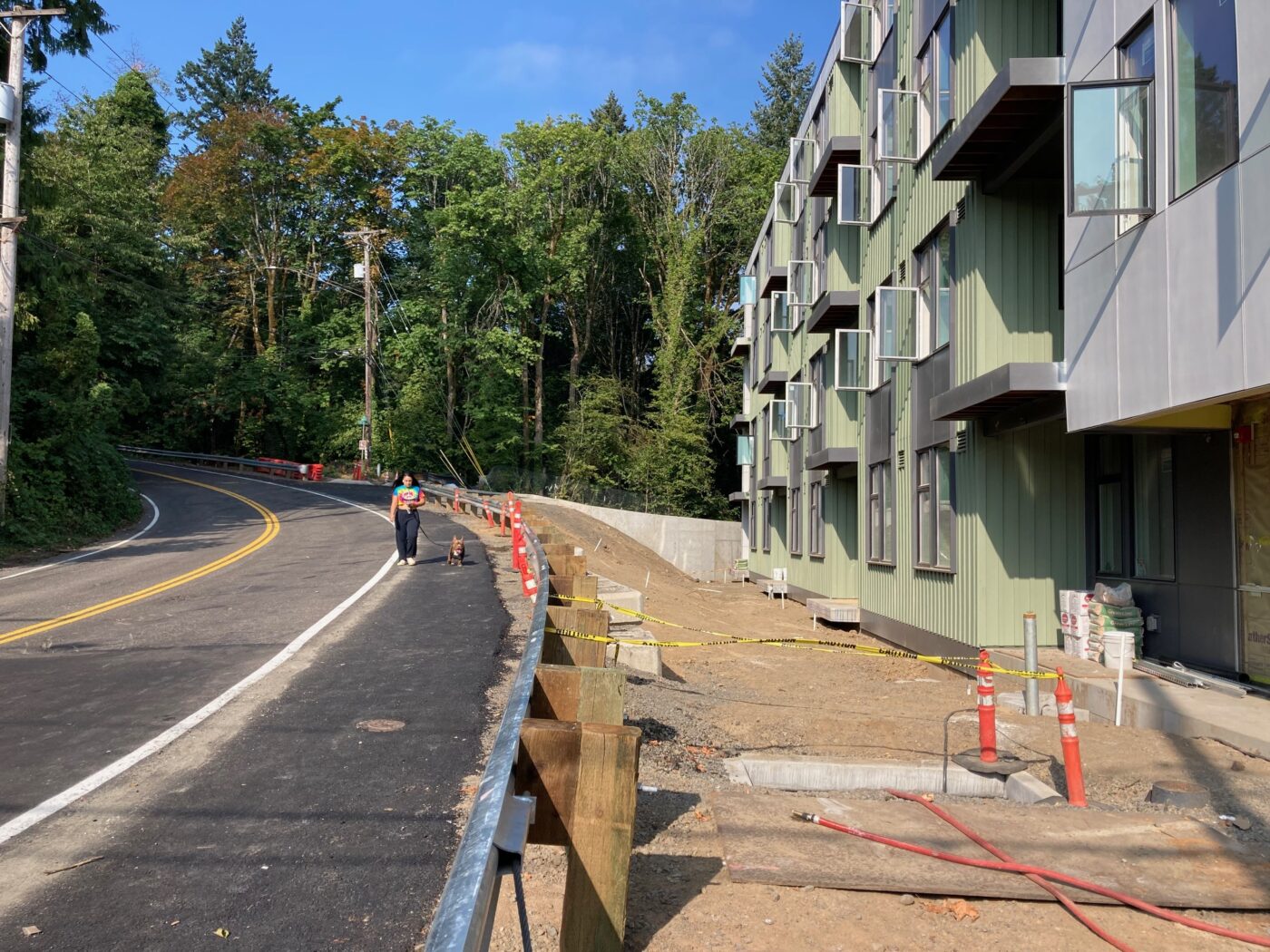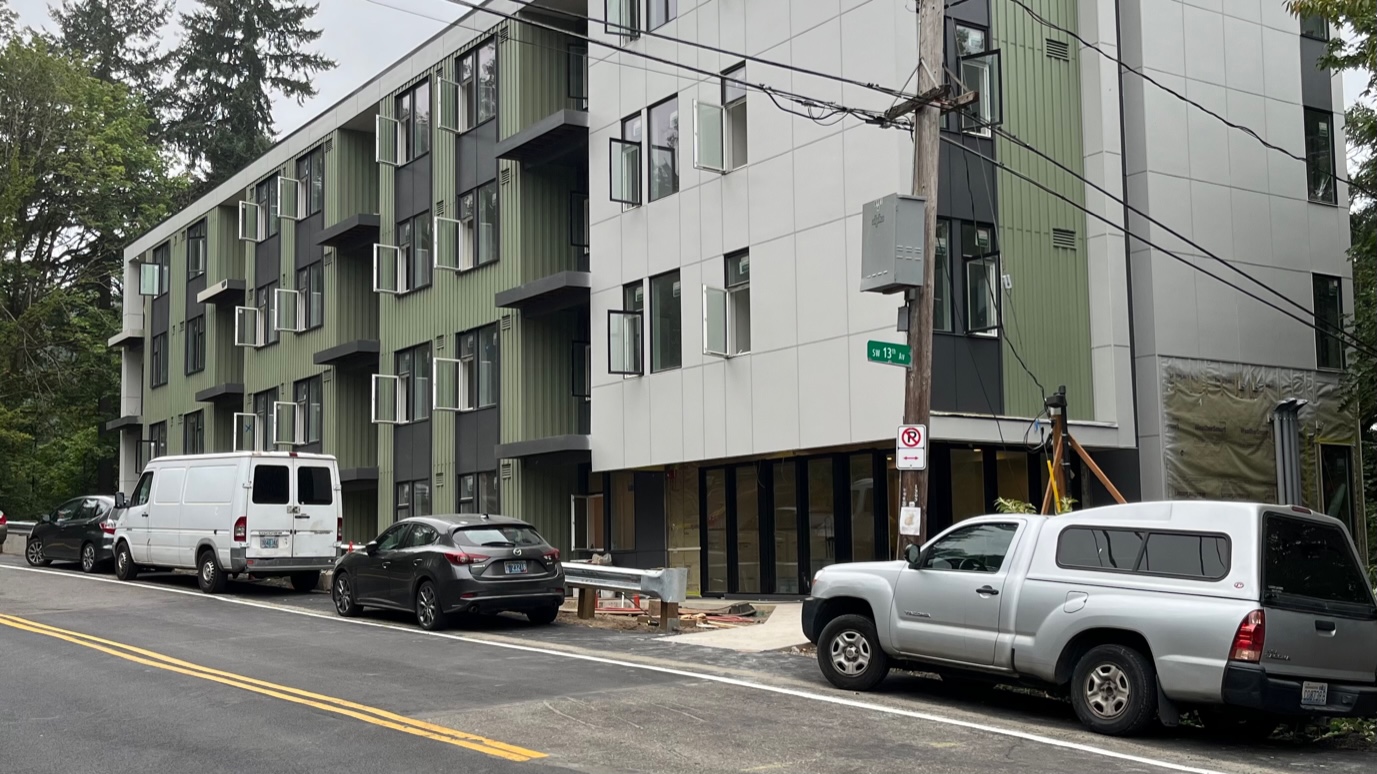
Nowhere to Walk on SW Gibbs
Previous stories in this series:
- A dispatch from SW Gibbs, where development doesn’t come with sidewalks
- Traffic impact studies: shouldn’t pedestrians and cyclists count?
- How Portland development rules perpetuate car use
- Early decisions in PBOT process baked-in SW Gibbs sidewalk fate
- Marquam Hill road closure leaves cyclists in lurch
- Gibbs, the Governor, or how I haven’t learned to love variances
It’s almost a wrap, and this is my seventh post in a year-long series about the permitting of a new, 43-unit apartment building on SW Gibbs Street, just up the road from the Oregon Health & Sciences University (OHSU) campus on Marquam Hill.
The Portland Bureau of Transportation’s (PBOT) Development Review desk signed-off on the building permit, but only required a five-foot asphalt shoulder for people to walk along rather than a sidewalk, despite Portland City Code 17.28.020 mandating that:
The owner(s) of land abutting any street in the City shall be responsible for constructing, reconstructing, maintaining and repairing the sidewalks, curbs, driveways and parking strips abutting or immediately adjacent to said land…
The site
This past month, workers completed the shoulder and we can now see what that looks like. The design has people walking in the narrow, banked street next to cars, along a guardrail which blocks the pedestrian from stepping off the roadway.
The land north of the street, between the guardrail and the building, is owned by the city—the property line runs about three feet in front of the building’s façade. Site plans show that the land between the guardrail and the building will be landscaped.
According to the most recent traffic and speed counts (2014 and 2018) Marquam Hill Rd (Gibbs becomes Marquam Hill Rd in the turn) carries between 3,000-4,000 cars a day, with 87% of the downhill drivers traveling above the posted 25 mph speed limit. This route is the only western entrance onto the OHSU/VA campus and is a popular cut-through for OHSU-bound drivers who exit westbound Hwy-26 at the Sylvan off-ramp miles before the more direct Hwy-405 Broadway Drive exit to OHSU, in order to avoid the tunnel traffic into downtown Portland and also to enjoy the beautiful drive over the hill.
Marquam Hill
I have written seven articles about Gibbs not because there is anything unusual about its “walking in the road” sidewalk treatment, far from it, this is typical of frontage improvements in southwest Portland.
No, if there is something special about the Gibbs treatment, it is that it is happening at this location. The new apartment building is just up the street from the OHSU emergency room; OHSU is Portland’s largest employer, and the premier medical center and biomedical research facility in Oregon; it has around a $4 billion operating budget and is currently building a $650 million hospital expansion. Gibbs Street is rapidly densifying with medium-sized apartment buildings and it has incomplete sidewalk coverage. The city imposed a parking cap on OHSU two decades ago which has resulted in limiting available parking to one spot for every three employees; consequently, OHSU had a pre-covid mode-share of 17% of employees commuting by bike.
“I live around here and I’d like to start riding a bicycle, but the road makes me too nervous.”
For cyclists, the widened shoulder provides a bike lane through part of the narrow curve, and makes that segment of the Gibbs/Marquam Hill route a little safer.
I spoke with a woman jogging on the new shoulder early Sunday morning and asked her what she thought. “It’s OK, I’m glad they put it on the outside of the curve—but I think it could be better.” When I mentioned to her that I was writing an article for BikePortland her face lit up. “I live around here and I’d like to start riding a bicycle, but the road makes me too nervous.” There are indeed lots of fast drivers and close passes on Marquam Hill Rd and Gibbs St.
By Monday morning work hour, the new shoulder on which she had been jogging was full of parked cars, as you can see in the photo above (on either side of the “No Parking” sign).
PBOT responds
I reached out to the Portland Bureau of Transportation (PBOT) earlier this week to see if they had a further statement about why a protected walkway at this location was infeasible, or to learn if they had modified their plans to include a path. Public Information Officer Dylan Rivera responded that,
PBOT always works to make sure our frontage requirements for development are reasonable, and when it comes to helping build housing such as this project on SW Gibbs, that is all the more critical to help the city address Portland’s housing crisis. PBOT worked with other city bureaus and the developer to require a wider shoulder, including some work outside their project area, to provide better access for people biking and walking than has been in place at the site on SW Gibbs. A standard sidewalk and protected bike lane would have required construction of an extraordinarily high and expensive retaining wall and movement of water and sewer lines.
Is there a solution to this?
Southwest Portland has the least sidewalk coverage, and the fewest completed bike routes of any area in the city and the current policy of requiring these facilities to be built piecemeal by developers as frontage improvements to land developments is not working well. The process is not transparent and relies on volunteers at neighborhood associations being savvy enough about permitting to effectively advocate for walkways and bike lanes.
The city should acknowledge this and commit to a plan to provide the infrastructure necessary to support environmentally responsible and safe growth in southwest Portland.



